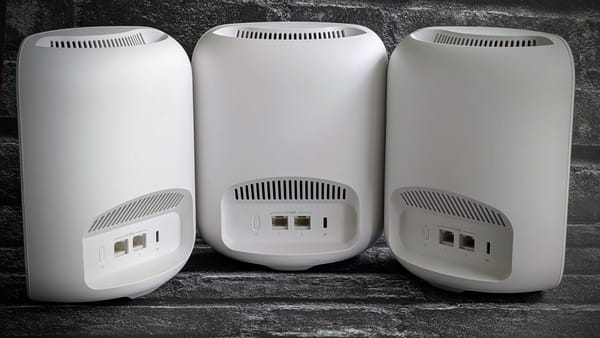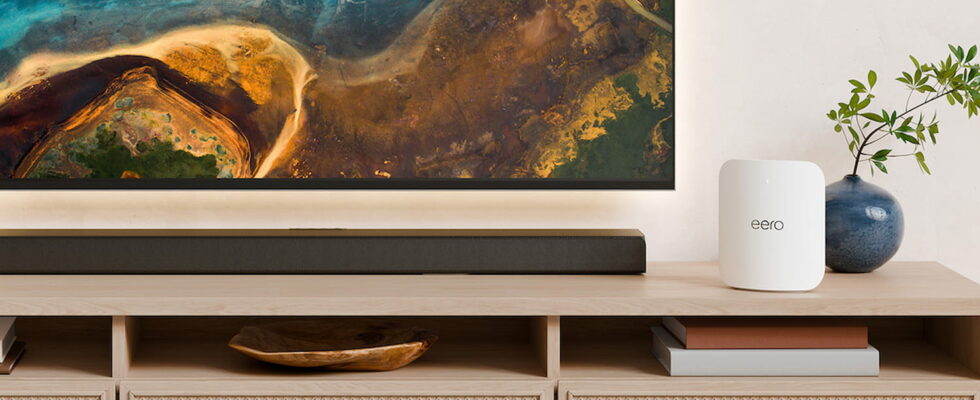To cover the whole house with a powerful wireless network doped at Wi-Fi 7, Amazon offers its new Mesh Eero Pro 7 kit. An elegant, simple to use and efficient set, but which remains expensive for conventional needs.
Entrust the management of its Wi-Fi network to Amazon? And why not. After all, it has already been 10 years that a subsidiary of the American online commerce giant offers its catalog wireless routers called Eero. They rub shoulders in the merchant’s stalls the Kindle readers, the HDMI Fire Stick keys or the Alexa connected speakers. Amazon is therefore not a beginner on the tech field.
The last version of its Eero router is available in three versions. The Eero Max 7, released more than a year ago, remains the most expensive (1999 euros for three modules) but has a very solid technical sheet with Ethernet 10 Gbit/s ports and a Wi-Fi 7 Tri-Bande connection (2.4, 5 and 6 GHz). Above all, it is intended for those who are equipped with a very efficient fiber connection and who want to enjoy excellent flows after their wireless connected devices. For more limited budgets, Amazon has just declined its Eero 7 router in two other versions. On the one hand the Eero 7 (very short), bi-band model (2,4 and 5 GHz) and the Eero Pro 7, which we test here. This router operates three frequency bands (2.4, 5 and 6 GHz) and can reach, depending on the brand, a wireless flow of 3.9 Gbit/s. It also has Ethernet 5 Gbit/s Ethernet ports. Not bad. It is intended for modern devices (computers, smartphones, tablets) compatible Wi-Fi 7 and also capable of exploiting the three frequency bands.
On the side of the prices too, the American giant defends himself well. The EERO 7 is billed 199 euros for a single module and 399 euros for the pack of 3. For better performance, the Eero Pro 7 is negotiated at 349 euros for a device and 799 euros for the three pack. A rate still high, far from satisfying the greatest number but which remains a bit below what is practiced at Netgear or TP-Link. A Wi-Fi kit which is therefore aimed above all with those which must cover a large surface while enjoying a stable and efficient wireless network.
|
|
Design: discreet and elegant boxes
Difficult exercise than that of making the eye pleasant as technophile as a Wi-Fi router. And yet Amazon is doing it hands down. The Eero Pro 7 blends easily without the decor. The case adopts a small template which is easily known on a narrow shelf. Its weight remains quite light too.

Each housing of the Wi-Fi mesh kit is identical, including the one that connects to the Internet box. At the rear, there are two 5 Gbit/s Ethernet ports, a reset button and a USB-C socket which allows the device to be connected to the sector with the supplied adapter.

Installation and settings: compulsory smartphone or tablet
All the boxes of the EERO 7 Pro kit are alike. So much so that we do not really know how to go about installing. Never mind. Everyone can act as a gateway. We then connect one of the boxes in the Ethernet box (no indication specifies whether to favor one of the two ports present), and we light.

Only Amazon’s EERO application, available on Android and iOS, allows you to start the configuration. After a compulsory registration with an Amazon account the unfolding of the operation is very simple. We are guided step by step to configure the router and connect his satellites at the right time. In all, it only took us for fifteen minutes to set up the new Wi-Fi 7 network. We took care in passing to give it the same name and password as the previous network. In this way, all of the previous connected devices automatically join it without requiring new settings.
Once the EERO devices have been configured, however, it is impossible to access it through a computer’s web browser. An option generally offered with all other routers (TP-Link, Netgear, Huawei, etc.). Here only the app on smartphone or tablet allows you to take control of it. Damage.

Ergonomics: a light interface and subscription options
Everything is so piloting from the EERO app for smartphone. Its interface is really easy to handle. She first lists the router and satellites online. A good way to know if one of them was not inadvertently disconnected. Then, it presents the list of all connected and online devices to Wi-Fi or Ethernet as well as all those who have connected at least once to the network (but which are not active at this moment). Practical to monitor that all devices present are identified. An option also allows you to receive an alert as soon as a new device connects to your network.
It is also possible to know the fastest download and loading speeds and access a history of the volume of data received and sent.

On the parameter side, it’s a bit light. The main options are there to define a network intended for guests, operate a port transfer, change DNS or even activate the multilian or not. This option allows compatible devices to connect to several frequency strips simultaneously to optimize the flows and reduce latency. It is deactivated by default since number of devices are incompatible with this operating mode (MLO). We also note in passing that the Eero knows how to manage Thread, Matter and Zigbee, the protocols to simplify the installation and the use of connected objects (yes, Amazon does not forget to try to sell Alexa speakers when possible). The main functions that are expected of a router are there but concentrated in the app. Access through the computer’s web browser, as offered in competition, would still have been more comfortable.

What we really regret, on the other hand, is to have to go back to the cash register to take advantage of parental control, security against viruses and malware, VPN or advertising blocking. So many subscription options which are each invoiced from € 10/month for a year. After relieving 800 euros for the kit, adding 40 euros monthly to take advantage of these additional advantages, that’s too much.
Performance: Cover to optimize
To measure the performance of this 7 mesh Wi-Fi kit, we installed the router near the Internet box. We distributed the satellites in two fairly distant bedrooms in an apartment of about 75 m2 saturated by the surrounding Wi-Fi networks. We then relied on the tool Openspeedtest To measure flows thanks to several compatible Wi-Fi 7 smartphones (Smasung Galaxy S24 Ultra, Xiaomi 15, etc.). We also used the NetSpot app for Windows to assess network coverage. Note that for this last exercise, we used an Asus under Windows 11 PC equipped with a Wi-Fi 7 Intel Be200 card (around 30 euros), our PC not being immediately compatible with Wi-Fi 7.
As evidenced by the thermal card below, the areas where the router and the satellites are located benefit from a very good signal. As with the Netgear Orbi 770 kit that we tested a few weeks ago, we met some cover concerns in the master bedroom. Worse, the PC disconnected from the network on numerous occasions by simply detecting it anymore. Our PC Asus (which is not of Wi-Fi 7 compatible original is perhaps the cause with antennas not optimized).
In the best of cases, we noted a signal at -37 DBM and in the worst, at -79 DBM. Not very satisfactory therefore compared to Netgear’s proposal. We also note that the PC often had trouble hanging the 5 GHz band. The 2,4 GHz and the 6 GHz being privileged most of the time.
On the side of the flows, the performance is rather very correct with 1.7 Gbit/s descending as much as possible in the room where the router is located and 558 Mb/s in the parental room, the space the least covered by the network. By comparison, we had obtained 1.3 gbit/s and 841 Mb/s respectively on the same test with the Netgear Orbi 770. In ascending debit, the kit has completely satisfactory results with at best 1.08 Gbit/s and at worst, 223.7 Mb/s. Figures that confirm that, whatever the room you are, it is still possible to work, play or watch a video in 4K without glitch.
Amazon Eero Pro 7: an effective Wi-Fi 7 kit but still expensive
Less imposing and bulky than Netgear’s Orbi 770 solution, and also a little cheaper, the Eero Pro 7 of Amazon offers completely acceptable performance. The devices are very easy to install and pilot. They are suitable for all those who do not feel very comfortable with the implementation and maintenance of a wired and wireless network. Informed users may feel a little more frustrated not to be able to access more advanced settings. For them, it will be necessary to turn to devices from manufacturers like Netgear or TP-Link to name a few. We just regret that all the parameters can only take place through the Android or iOS app.
There remains the thorny question of the price. Is it really necessary to pay 800 euros to enjoy a Wi-Fi 7 network throughout the house? Not sure if you already have a 6th Wi-Fi network or even high-performance Wi-Fi 6 with suitable repeaters. To this are also added the new boxes of operators. Bouygues has just equipped his with Wi-Fi 7, Free has had the Ultra Freebox for a year (with a version of the Wi-Fi improved recently), Orange is on rails and SFR… is thinking about it. Free also offers repeaters, one of which is included for free with its box.
In other words, at a lower cost it is also possible to enjoy Wi-Fi 7 in the house. However, the rates and coverage offered may not suit the most demanding users who wish to make the most of their fiber connection and their very recent devices that support this standard. Wi-Fi 7 still remains an investment whose profit is to be considered in the long term, even at Amazon.

